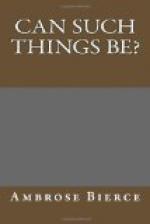“Perhaps,” he replied, apparently unaffected by my foolish irony, “you may be able to infer their convictions from their acts. I will spare you the familiar examples of the sensitive mimosa, the several insectivorous flowers and those whose stamens bend down and shake their pollen upon the entering bee in order that he may fertilize their distant mates. But observe this. In an open spot in my garden I planted a climbing vine. When it was barely above the surface I set a stake into the soil a yard away. The vine at once made for it, but as it was about to reach it after several days I removed it a few feet. The vine at once altered its course, making an acute angle, and again made for the stake. This manoeuvre was repeated several times, but finally, as if discouraged, the vine abandoned the pursuit and ignoring further attempts to divert it traveled to a small tree, further away, which it climbed.
“Roots of the eucalyptus will prolong themselves incredibly in search of moisture. A well-known horticulturist relates that one entered an old drain pipe and followed it until it came to a break, where a section of the pipe had been removed to make way for a stone wall that had been built across its course. The root left the drain and followed the wall until it found an opening where a stone had fallen out. It crept through and following the other side of the wall back to the drain, entered the unexplored part and resumed its journey.”
“And all this?”
“Can you miss the significance of it? It shows the consciousness of plants. It proves that they think.”
“Even if it did—what then? We were speaking, not of plants, but of machines. They may be composed partly of wood—wood that has no longer vitality—or wholly of metal. Is thought an attribute also of the mineral kingdom?”
“How else do you explain the phenomena, for example, of crystallization?”
“I do not explain them.”
“Because you cannot without affirming what you wish to deny, namely, intelligent cooperation among the constituent elements of the crystals. When soldiers form lines, or hollow squares, you call it reason. When wild geese in flight take the form of a letter V you say instinct. When the homogeneous atoms of a mineral, moving freely in solution, arrange themselves into shapes mathematically perfect, or particles of frozen moisture into the symmetrical and beautiful forms of snowflakes, you have nothing to say. You have not even invented a name to conceal your heroic unreason.”
Moxon was speaking with unusual animation and earnestness. As he paused I heard in an adjoining room known to me as his “machine-shop,” which no one but himself was permitted to enter, a singular thumping sound, as of some one pounding upon a table with an open hand. Moxon heard it at the same moment and, visibly agitated, rose and hurriedly passed into the room whence it came. I thought it odd that




